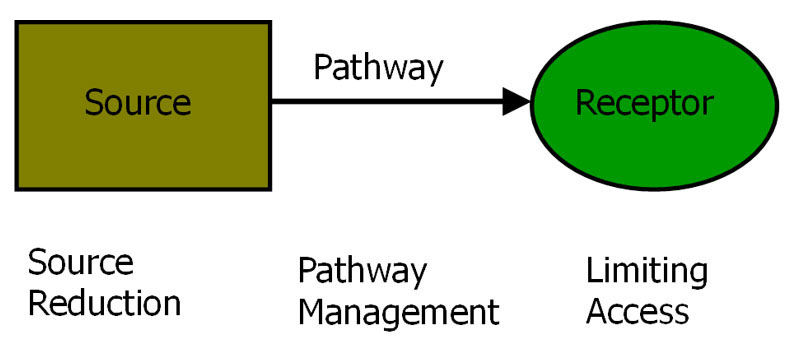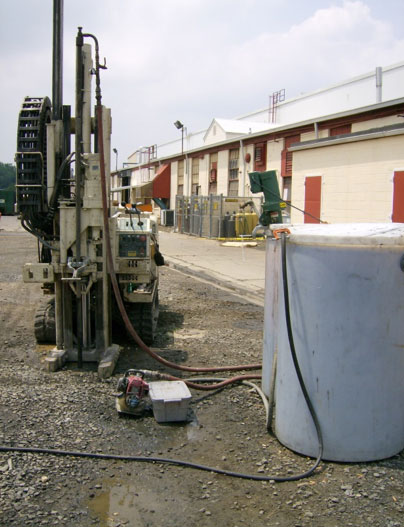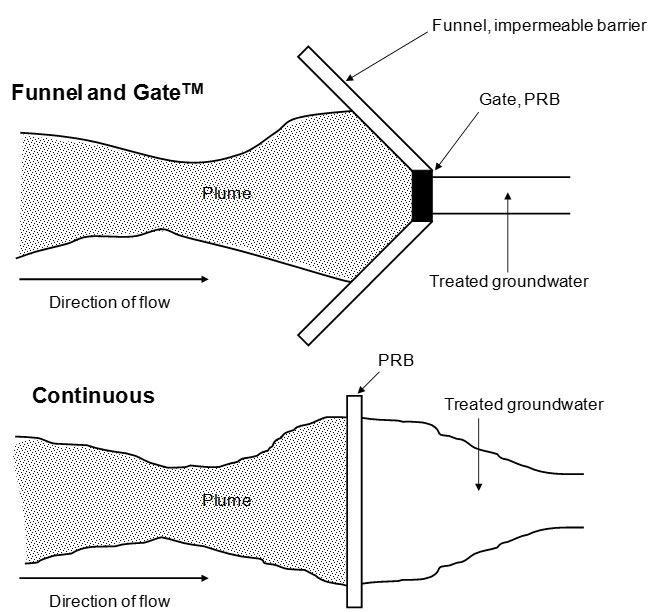Contents
1. Aim
2. Introduction
3. Types of Nanoparticles Used in Remediation Projects
4. Application of Nanoremediation in the Field
5. NanoRem Activities
6. Additional Resources on the NanoRem Web Site
7. Feedback and Opinions
1 Aim
The aim of this page is to outline the use of nanoremediationprojects, nanoparticles used, and to describe how the particles are introducedinto the ground. More detailed information is available from the NanoRem ToolBox (http://www.nanorem.eu/toolbox/index.aspx#TB1).
2 Introduction
For a human health or wider environmental risk to exist, allof the following must be present - a source of contamination (S), a receptor(R) and a pathway(s) (P) linking the two - i.e. a contaminant or pollutant linkage(S-P-R). If any of the above links are absent then there is no environmentalrisk. In most cases where a contaminant linkage exists, riskmanagement is achieved using a combination of measures, such as contaminantmass removal (source); plume control (pathway management); and institutionalcontrols (restricting use of a resource) to break the linkage as shown inFigure 1. A rangeof technologies have been developed to manage contaminant linkagesutilising civil engineering approaches, and physical, chemical and biologicalprocesses..


Figure 1 Possible Risk Management Actions
An emerging in situ technology is nanoremediation, toreduce the source and/or to manage the contaminant plume along the pathway.Since the first documented case of nanoremediation being trialled in the fieldfor groundwater contamination in 2000, at Trenton, New Jersey, USA, up to 2013,over 100 nanoremediation projects have been documented at either pilot or fullscale worldwide.
The most common usage of nanoremediation documented in thefield has been in pathway management where an in situ treatment zone iscreated by the direct injection of nanoparticles in order to treat a definedvolume of aquifer. This technology will usually be targeted at parts of theplume with high dissolved contaminant concentrations. NanoRem is alsoinvestigating whether nanoparticle based remediation technologies can providemore effective source management approaches in comparison with other technologies.
Further information is available from the NanoRem Report “DL9.2Final Exploitation Strategy, Risk Benefit Analysis and Standardisation Status”,downloadable from the NanoRem Tool Box (http://www.nanorem.eu/toolbox/project-deliverables.aspx).
3 Types of Nanoparticles Used in Remediation Projects.
A range of nanoparticles are being used or are indevelopment for nanoremediation. Nanoparticles, such as nanoscale zerovalentiron (nZVI), are by their nature highly reactive. Their active lifespan insitu is limited by a number of processes:
- Agglomeration - where nZVI particles are attracted to each other and aggregate into larger particles. In almost all cases this reduces their effective surface area and their mobility in water.
- Passivation - where nanoparticle surfaces are chemically inactivated (although activity may remain within particles).
- Immobilisation in the aquifer solid matrix (e.g. through the processes of sorption).
These processes place limitations on treatment effectivenessby restricting the ability of nanoparticles to reach and treat contaminants insitu.
To overcome these limitations, a number of modificationshave been developed to improve the effectiveness of nZVI by reducing the scaleof agglomeration and the immediacy of passivation. These include:
- Stabilisation – using a range of coatings, including biopolymers such as starch, chitosan, and carboxymethyl cellulose.
- Emulsification - where aqueous nZVI is surrounded by an oil-liquid.
- Anchoring nZVI onto carbon, cellulose acetate, polymeric resin or silica to prevent agglomeration and aid dispersion of the nZVI.
Other modifications have included the development ofbimetallic nanoparticles (BNP) which typically utilize small quantities (i.e.<1% by weight) of other metals (e.g. nickel, palladium, platinum, etc.) toserve as catalysts to increase reaction rates and the types / ranges ofcompounds that are amenable to reduction by the iron. NanoRem has developed a range of nanoparticletypes, some based on zerovalent iron and some not. These are described in the NanoRem Tool Box (http://www.nanorem.eu/toolbox/nanoparticles_and_tools.aspx#TB1).
4 Application of Nanoremediation in the Field.
There are two main methods by which nZVI particles tend to beapplied in the field: direct injection into the aquifer, and potentiallycontained in situ treatment applications such as the matrix of anengineered permeable reactive barrier. Published field studies show theapplication of all nZVI, including modified forms, has been by directinjection.
4.1 Direct Injection
Direct injection is used in both source and pathwaymanagement. In pathway management it is used to create an in situtreatment zone for a defined volume of aquifer.
The performance of directly injected remediation projects isconstrained by the ability of the nanoparticles to disperse throughout theaquifer to ensure the entire contaminated plume is addressed. Thisaccessibility is constrained by the permeability of the subsurface, subsurfaceheterogeneities and their potential to limit flow and/or create preferentialpathways of flow and discontinuities such as the phase difference between thegroundwater and the non-aqueous phase liquid (NAPL).
The aim of the injection process is to introduce a knownamount of nanoparticles into the aquifer at a known depth, (see Figure 2). Theinjection may be gravity fed or introduced under pressure (either pneumatic orhydraulic). The main injection processes commonly used are:
- Direct push techniques involving a direct push rig or stationary injection point to introduce nZVI slurry into the treatment zone.
- Pneumatic or hydraulic fracturing uses air or water to create a fracture network of preferential flow paths around the injection point and enhance nZVI distribution.
- Pressure pulse technology uses regular pulses of pressure while injecting the nZVI slurry.
- Liquid atomization injection combines an nZVI-fluid mixture with a carrier gas (for example nitrogen) to create an aerosol that can be dispersed into the treatment zone.
- Injection via a gravity feed.
- Injection using foam surfactant carrying nZVI for delivery of nZVI into the vadose zone (developed to lab-scale: Ding et al. 2013, Shen et al. 2011).
To facilitate pumping the nZVI particles are generallyintroduced as a pumpable slurry, e.g. in water or vegetable oil.


Figure 2 - Direct Injection of nZVI in the Field at the Trenton Facility, New Jersey (Photo courtesy of Geosyntec Consultants)
The operator may wish the natural groundwater process (advection and diffusion) to carry the reactive media away from the injection point, or may wish to actively control the process using pumping methods. This can include the use of pumps to direct the downstream groundwater flow or the use of recirculation pumps. Recirculation may be used via up-gradient injection wells and down-gradient extraction wells to improve delivery of the particles. In this case abstracted groundwater is reconditioned and mixed with additional nanoparticles and re-injected in the injection wells. (US EPA 2008).
4.2 Permeable Reactive Barriers (PRB)
A permeablereactive barrier or treatment wall treats dissolved phase contaminants in afixed treatment zone within the groundwater flow path. The treatment zone canbe considered conceptually in three parts: an active agent; a permeable matrixthat supports and anchors the agent; and an amenable containment for thismatrix. There are many possible PRBconfigurations ranging from highly engineered approaches like the Funnel andGateTM (Figure 3) where sheet piling or slurry walls directgroundwater flow in a funnel to an engineered treatment gate which contains thematrix and its active agents; to barriers where an active agent is simplyinjected or trenched in situ in a form that does not migrate. In thislatter case the aquifer materials form the containment and the matrix.


Figure 3 - Funnel and GateTM and Continuous PRB Configurations (from Nathanail et al. 2007)
The use of micro sized zero valent iron within PRBs to treatplumes of chlorinated solvents has been well documented, and researchers havesuggested that nanoparticles may also be suitable as the active componentwithin the PRB matrix. The relatively short life span of active nZVI particles wouldappear limit their usefulness in a PRB, unless the gate can be regularly recharged,or stabilised in some kind of a
5 NanoRem Activities
The NanoRem project has provided comprehensive information aboutthe application of nanoremediation including:
- The production of a number of different nanoparticles.
- The fate of nanoparticles within the saturated sub-surface.
- The effectiveness of these particles in treating different contaminants.
- Issues affecting scale up from bench to field using large tank experiments.
- The ease, or otherwise, of injecting the particles into the sub-surface.
- Methods for field scale observation of nanoparticle performance.
- Cost and performance information from field based case studies.
Detailed applications guidance is available from the NanoRemTool Box (http://www.nanorem.eu/toolbox/nanoparticles_and_tools.aspx#TB1).
6 Additional Resources on the NanoRem Web Site
Comprehensive resources are available from the NanoRem ToolBox, shown below (http://www.nanorem.eu/toolbox/index.aspx):

Additional summary information is also available on the following online pages:
FAQs
THEMATIC PAGES